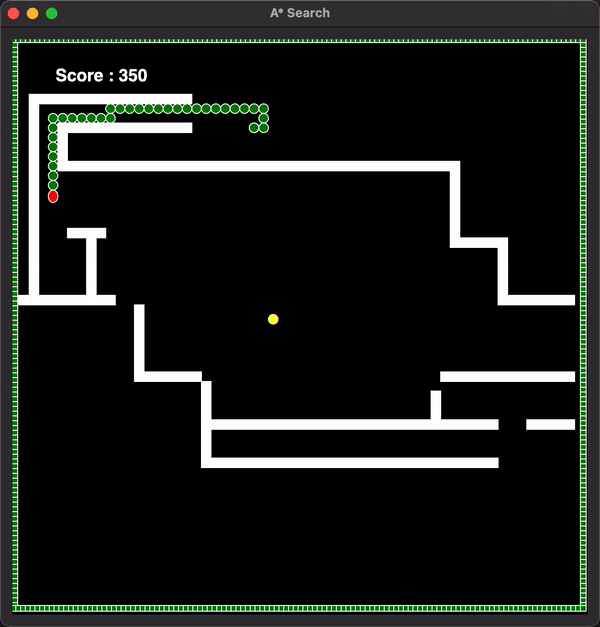A Snake Chaser Game with body implementation, built using AI search algorithms.
Project Source
This project is open-source and you can find it here.

Search Algorithms Implemented
Variety of search algorithms were implemented to study and compare them.
A* Search
- Implementation Details: Uses a priority queue based on the sum of the cost to reach a node and a heuristic estimate to prioritize node expansion. Utilizes the Manhattan distance as the heuristic function to estimate the cost from a node to the goal.
- Working: Begins with the source node and explores nodes with the lowest estimated total cost first. Expands nodes by generating possible moves, evaluating their costs, and updating the priority queue accordingly. Continues until the goal node is reached.
Greedy Best-First Search (GBFS)
- Implementation Details: Employs a priority queue but prioritizes nodes solely based on their heuristic values.
- Working: Starts from the source node and expands nodes with the lowest heuristic values, aiming to move closer to the goal quickly. Expands nodes by evaluating potential moves, updating the priority queue based on their heuristic values. Stops when the goal node is reached or no more nodes are left to explore.
Uniform Cost Search (UCS)
- Implementation Details: Utilizes a priority queue based solely on the actual path cost from the initial state to prioritize node expansion.
- Working: Begins with the source node and expands nodes based on their path costs from the initial state. Considers all possible moves from each node, evaluating their costs and updating the priority queue accordingly. Continues until the goal node is reached or no more nodes are left to explore.
Additional Integrated Features
- Integrated Multi-processing for parallel processing of 3 different algorithms.
- Handled the body increasing scenario where the snake’s body increases after eating food.
- Each algorithm caters the body movement for each step it takes and thus knows where the body will move if it takes a step. This introduces efficiency in the algorithms as they can make moves really close to the body and compute the efficient path even if it’s close to the body.
Test Mazes
We used three different types of mazes for testing the efficiency and effectiveness of our search algorithms and we also ran the snakes for infinitely to see which runs the longest among all.
- No Hurdles Maze
- Small Grid 30*30 Hurdle Maze
- Standard 60*60 Hurdle Maze
Instructions to Reproduce / Run
Make sure your terminal is open in the project folder.
Run the following command to launch all agents:
python launch.py
Info
Run the following command structure with provided arguments to run specific agent:
⇒ python main.py [A*/GBFS/UCS] [COLOR] [MAZE.TXT] [GAME WINDOW TITLE]
Example:
python main.py A* green Maps/hurdlesMaze.txt "A* Implementation"
All agents run with the same random seed. Thus the food respawns at the same locations for each agent istance.
Results/Comparison
Proper documentation and sample trailer videos are available under documentation folder in the provided source.
No Hurdle Maze
Target 500 score
| Algorithm | Time Taken in minutes |
|---|---|
| A* | 1:33.17 |
| GBFS | 1:33.79 |
| UCS | 1:35.73 |
Small Grid
30x30 Hurdle Maze - Target 300 score
| Algorithm | Time Taken in seconds |
|---|---|
| A* | 37.41 |
| GBFS | 38.61 |
| UCS | 38.58 |
Standard
60x60 Hurdle Maze - Target 500 score
| Algorithm | Time Taken in minutes |
|---|---|
| A* | 2:44.53 |
| GBFS | 3:13.83 |
| UCS | 2:48:54 |
Hardcore
60x60 Hurdle Maze - Last to stop wins (infinite)
| Algorithm | Time Taken in minutes | Score | Snake Length | Positions |
|---|---|---|---|---|
| A* | 8:56.44 | 1110 | 111 | 1st (winner) |
| GBFS | 7:34.10 | 910 | 91 | 2nd |
| UCS | 3:36.17 | 580 | 58 | 3rd |

